- Circulatory system
- Respiratory system
- Nervous system
- Digestive system
- Excretory organs
- Reproductive system
From the point of view of biology, a cockroach is one of the unique insects that have preserved archaic features. The ancestors of modern pests appeared in the Paleozoic and the structure of the cockroach was even more primitive than that of today's descendants. But the changes were more "cosmetic." They did not affect the basic functions of the body.
The internal structure of the cockroach
This is one of the first arthropods who switched to a land-based lifestyle. The internal systems of cockroach and cancer are still similar. But there are differences. Since the cockroaches went on land, they appeared additional organs that formed two systems: the respiratory and excretory. The rest of the internal structure of the cockroach and other arthropods has no differences.
Interesting!
Insects and aquatic arthropods also do not have an internal skeleton. Its role is played by chitinous shell.
Circulatory system
The cockroach in the usual sense for us, the cockroach does not. The role of the heart is played by a blood vessel attached internally to the upper side of the chitinous cover. The heart looks like a tube with extensions in each of the segments of the abdomen. Thus, the "heart" runs along the entire body of the insect. Each expansion chamber has ostia: openings through which “blood” from the body of the insect enters the heart.
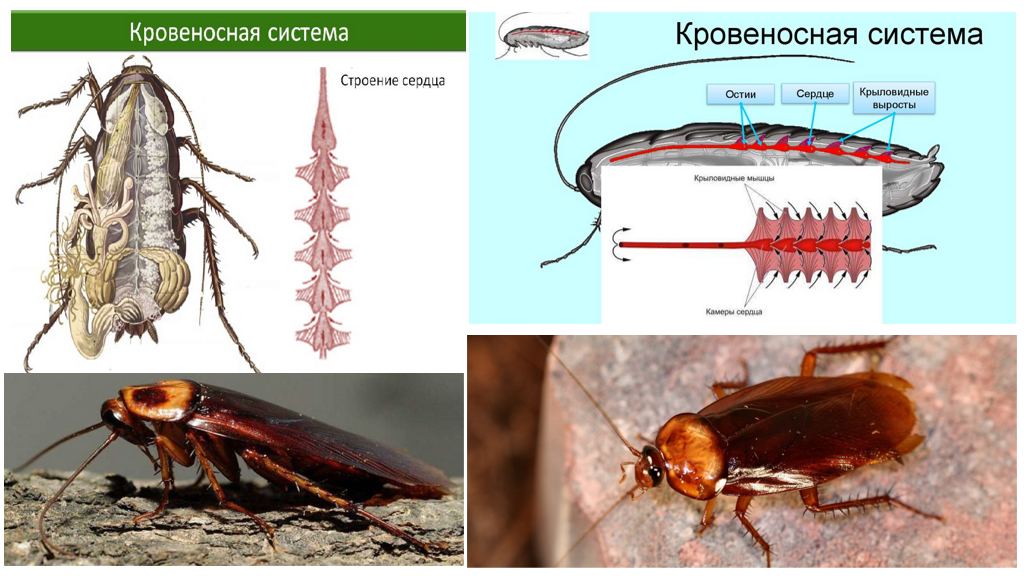
The back end of the heart is deaf. Front open. The front of the heart, which does not have extensions, is called the aorta. Since the front end of the heart is open, blood pours out of it into the internal cavity of the cockroach's body.
The heart is attached to the back of the cockroach using muscles that have a triangular shape. Since the tube itself cannot pulsate, the muscles make it contract and expand.
When the tube expands, the openings in the ostia act like vacuum pumps, and blood from the body cavity enters the heart tube. During compression, the valves in the ostia are closed, and the blood again enters the internal cavity through the open front end of the aorta.
Interesting!
The heart of a cockroach contracts in waves, and the waves go from the rear end to the front. The cameras are squeezed alternately. In fact, blood is pushed out into the system of gaps.
Respiratory system
The peculiarity of the structure of the respiratory system in the powerful branching of the trachea, which resembles the structure of trees. In cockroaches, blood does not deliver oxygen to the cells of the soft tissues, and the trachea has taken on this responsibility.
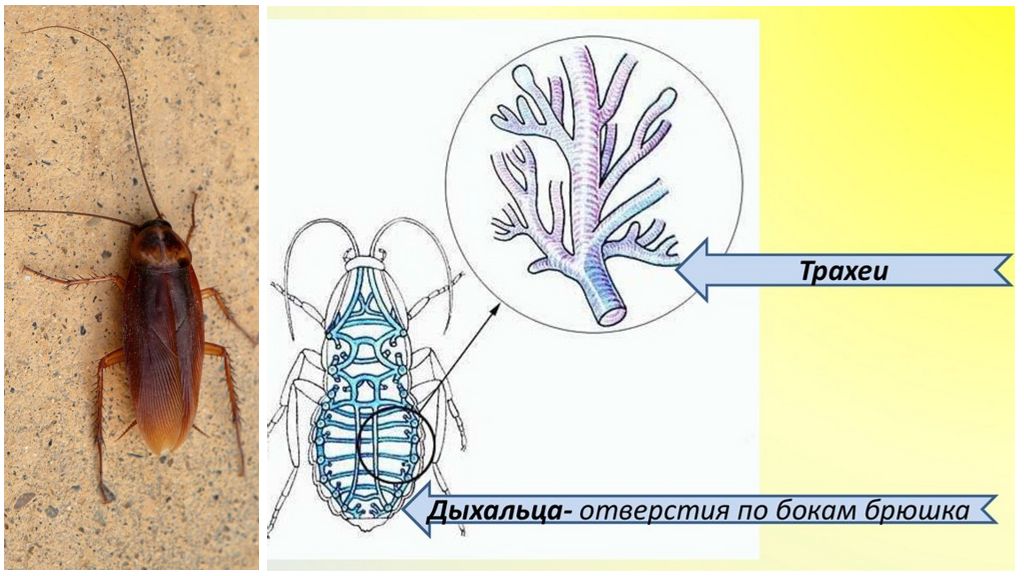
Air into the trachea enters through a special hole-spiracles located on the underside of the abdomen and thoracic region. There are 10 pairs of spiracles in the insect: 8 of them are in the abdominal segments and one pair in the posterior and mesothorax. All spiracles located on one side are connected by a common tracheal trunk.
There are 3 pairs of such powerful tracheas. The most powerful pair are the side trunks passing on both sides of the cockroach's body. Two more pairs run parallel to the central axis of the insect: one above and one below. The top pair goes along the heart of the cockroach. The lower one is parallel to the neural chain.
All major tracheas are connected into one system by transverse tubes. From this "skeleton" of the respiratory system, thinner tubes depart, which branch and thin out as they branch. At the final stage, the breathing tubes become a few microns in diameter. This network braids all the insides of the cockroach, delivering oxygen to each cell of the insect's body.
On a note!
Tracheoles deliver oxygen directly to each cell. These are very thin tubes with a diameter of less than a micron. The end result of branching trachea.
Nervous system
The basis of the structure of the central nervous system in a cockroach is a chain of ganglion nerve nodes that stretches along the entire body. The first node, often called the brain, is located in front of the pharynx. The real name is the pharyngeal ganglion. The nerve endings depart from it to the organs located on the head: upper lip, to the eyes and mustache.
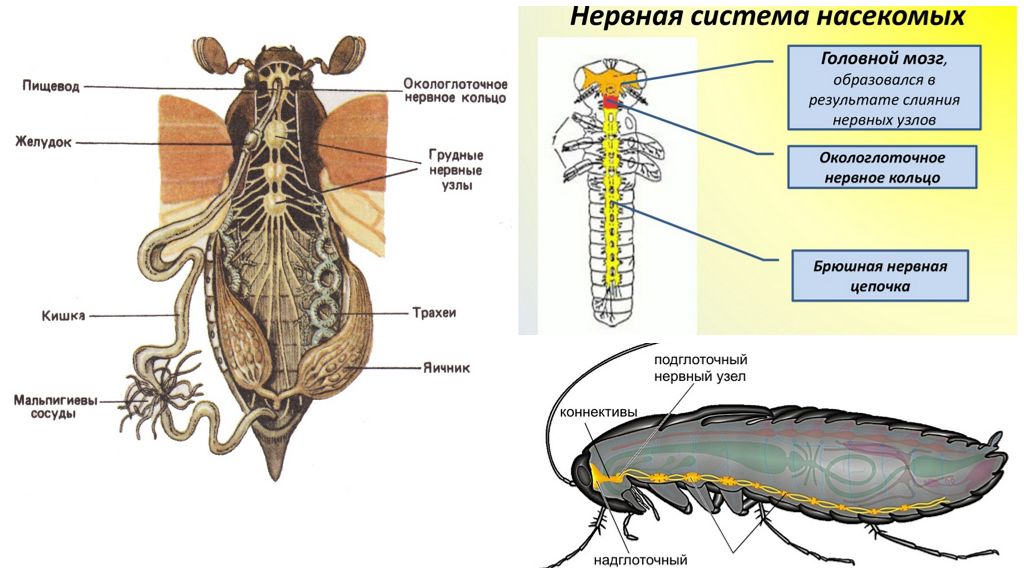
The nerve fibers-connectives the brain is connected with the subpharyngeal ganglion. This node controls the lower lip and jaws.
The following three nodes are located in the thoracic region, one in each segment. The nodes are not paired, but the presence of paired connections indicates that once there were three more nerve nodes in the cockroach. The thoracic ganglia are responsible for the movement of the limbs: paws and wings.
In the abdomen there are 6 more nerve nodes. The last of them is formed at the merger of 5 segments at once: from 6 to 10.
Digestive system
Begins with the oral cavity. The ducts of the salivary glands are located behind the subpharyngeal nerve node.
The salivary glands are paired, clustered, well developed. Associated with large tanks. The saliva entering the oral cavity moistens the rubbed food liberally, making swallowing easier.
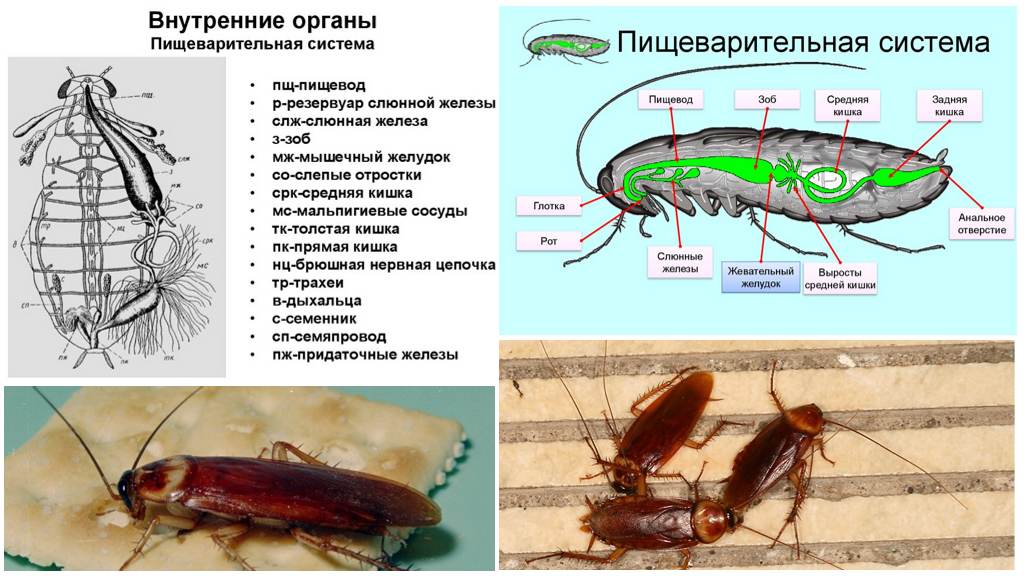
Behind the ducts of the glands is a pharynx, which passes into the tubular esophagus. The latter, expanding, passes into a sack-like goiter. Next is the chewing stomach. And all these are just parts of the anterior intestine. The back of the stomach has transformed into a valve that passes food into the middle intestine.
The latter looks like a cylindrical tube with 8 blind outgrowths at the border with the anterior section. The processes only increase the area of the middle intestine. In this gut, food is finally digested.
The middle intestine passes into the back, which is divided into departments:
- very short small intestine;
- long thick;
- extended rectal section.
The latter ends with the anus.
Excretory organs
These include malpighian vessels and fat body. The vessels are located at the junction of the middle and hind intestines and look like thin tubes blind on the free end.
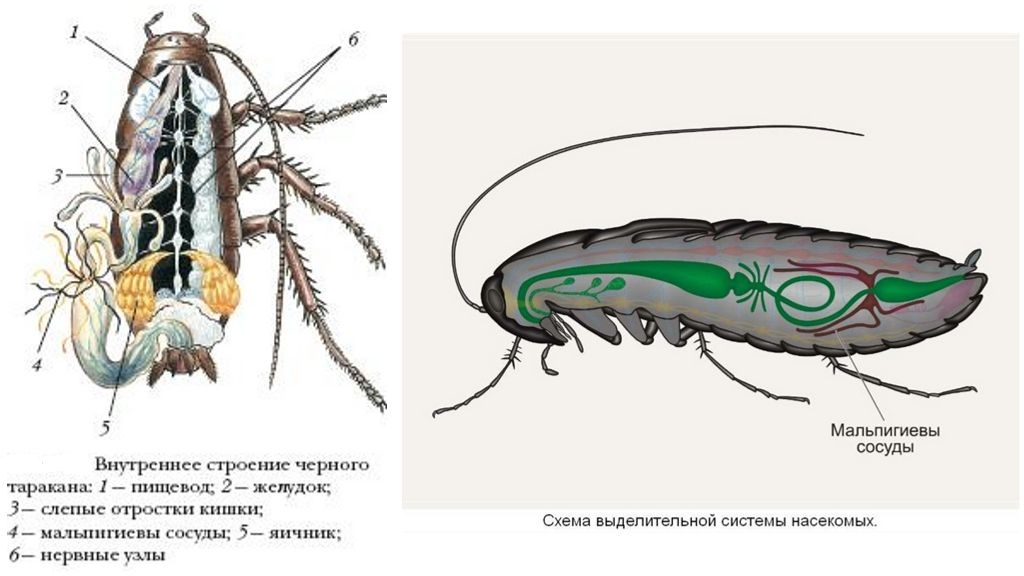
Interesting!
At black eastern cockroach such tubes can be more than a hundred.
The function of malpigium vessels is the excretion of uric acid, calcium and sodium salts, and more.
Fat body - an additional organ of the excretory system. It looks like a white loose mass. The fat body absorbs metabolic products from the body, but does not secrete them, but accumulate them. In this body, all metabolic products remain until the end of the life of the cockroach. The fat body accumulates nutrients that save the insect from death during a hunger strike.
Reproductive system
The reproductive system of the female cockroach consists of the ovary, adnexal glands and duct. The ovary is two clusters of 8 tubes. The part of the tubes facing the interior of the body cavity is pointed, and the opposite end is greatly expanded.
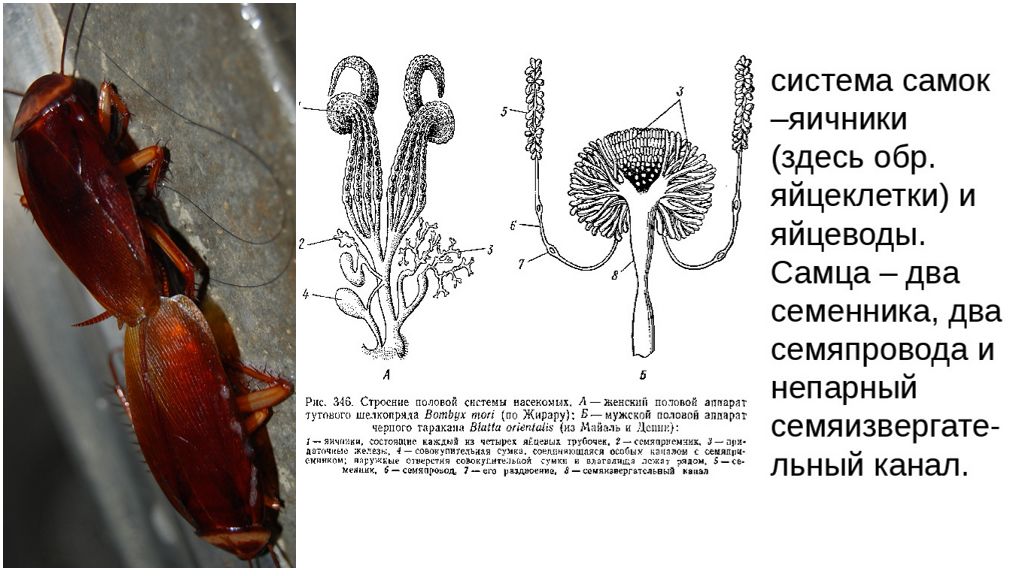
Egg begins to form inside the tube in the end section. As it develops, it moves to the expanded part and falls into the vagina, which opens out. Eggs go strictly in pairs. And in the vagina an ooteka is formed, which will subsequently be postponed in a secluded place.
Anatomy of the male genital apparatus is simpler:
- 2 testes;
- 2 vas deferens;
- 1 ejaculatory canal;
- adnexal glands.
External structure
The body of a cockroach consists of 3 parts: the head, chest and abdomen.The chest and abdomen have their own segments.
Head
The heads of black and red cockroaches have a similar triangular shape. But for black the head "hides" under the chest shield, and for red prusak "Set vertically." The shape of the head is an isosceles triangle with rounded corners and a downward-pointing apex.
Large facet eyes are located on the sides of the head, on the front surface there are two more simple eyes. The long mustache consists of many small segments. Mustaches are fastened in the holes intended for this.
Interesting!
The male’s mustache is longer than that of the female.
Oral apparatus gnawing type directed downwards and includes:
- semicircular upper lip;
- a pharynx replacing a cockroach's tongue;
- 3 pairs of jaws;
- salivary gland opening;
- the lower jaw.
The oral apparatus of the cockroach is well suited for grinding solid food and liquid consumption.
Chest
Consists of 3 parts:
- Pronotum. The largest segment of the three. It has the shape of a hexagon. There are hollows on it, where the insect stacks elytra.
- The pronotum connects to the second segment, which has the shape of a triangular shield.
- Five-membered are attached to the thoracic region from the underside paws. The tips of the paws are equipped with claws and suction cups. The second segments of the legs are protected by sharp spikes. In red cockroaches, protection is invisible, but the larger the insect, the more noticeably prick these spikes.
Wingslocated on the back of the insect, may be underdeveloped, as in females of black cockroaches, or fully developed, like in Prussians.
Interesting!
Sexual dimorphism of the Prussians is also expressed in the length of the wings: in males they are longer than the abdomen, in females the length of the wings does not extend beyond the tip of the abdomen.
Abdomen
The abdomen consists of 10 to 11 segments. The last of them is transformed into the anal plate, which closes the anus. Entomologists will determine the sex of the same plate in those species in which sexual dimorphism is not expressed.
On the abdomen there are stigmas - holes through which the cockroach breathes. At the tip of the abdomen are tserki - reduced ovipositors of ancient cockroaches.
In a red cockroach, sex can sometimes be determined by the size of the abdomen: in a female, it is thickened.
Ooteka
Not included in the description of cockroaches, as the function is temporary and is found only in females. This is a cocoon for oval eggs with rounded edges. Usually ooteka brown in different shades.
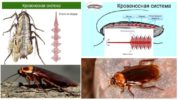
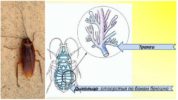
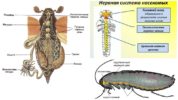
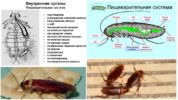
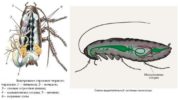
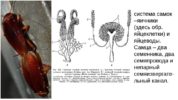
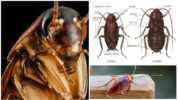
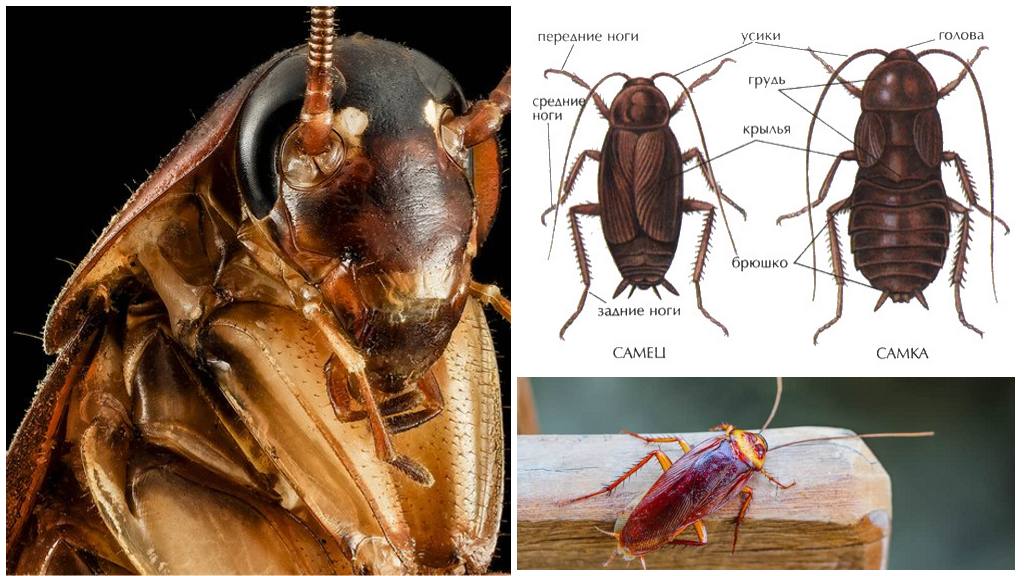


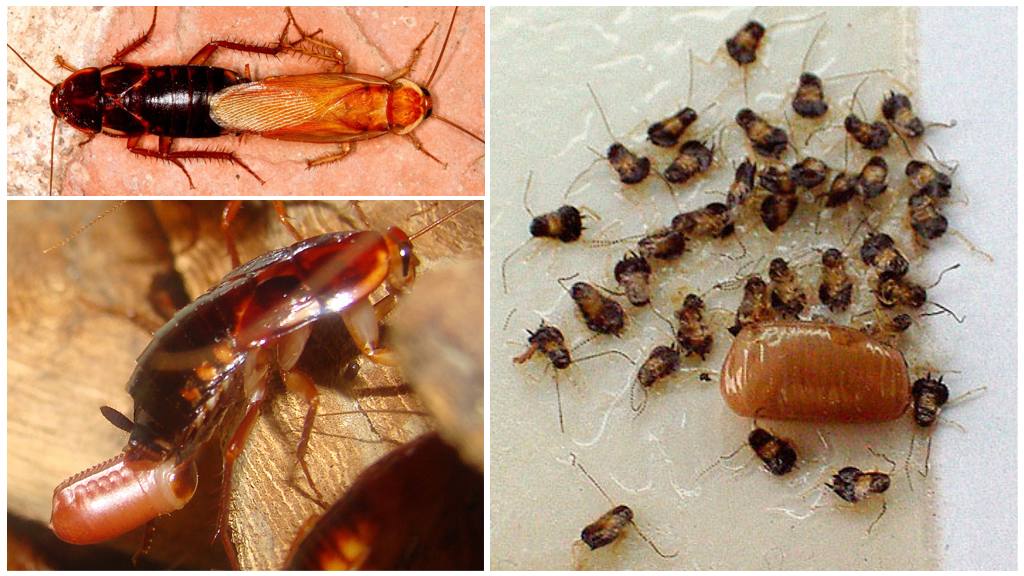
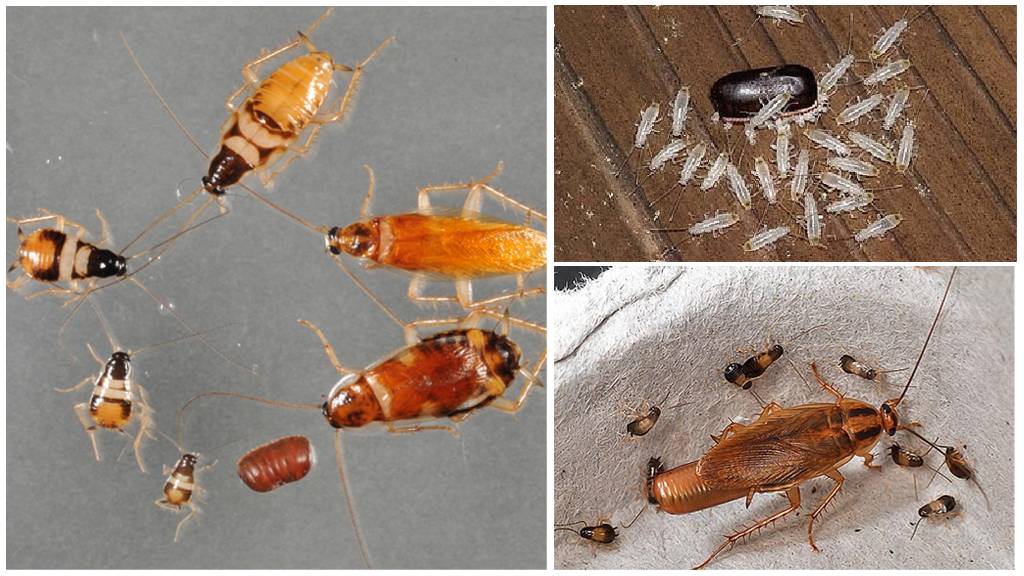
An interesting structure of cockroaches. Most surprising is their ability to exist for some time without a head.